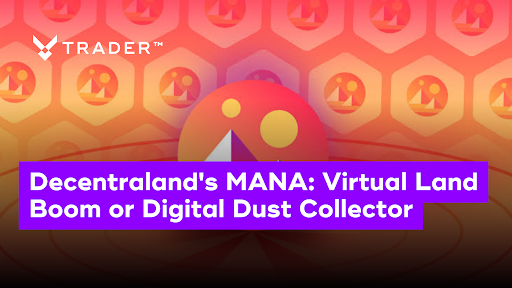Decentraland in 2025: Digital Gold Rush or Empty Lots?
MANA is still around. That might surprise you. The token that powers Decentraland’s virtual real estate game sits at $0.45 with a market cap of $840 million (CoinGecko, June 5, 2025). In 2021, it was one of the loudest voices in the metaverse hype cycle. NFTs, virtual land auctions, parties hosted by Adidas and Sotheby’s—it was a moment.
Now? It’s down 92% from its $5.90 high. The heat is gone. Trading volume is a fraction of what it used to be. Daily activity? Thin. But scroll X and you’ll still find diehards hyping land sales, whispering about partnerships, claiming MANA is due for a comeback.
Depends on how you define “comeback.”
What Decentraland Still Has Going for It
Decentraland launched early and did one thing right: it gave people digital land they could actually own. Virtual parcels minted as NFTs. You could build on them, rent them out, resell them, or let them sit.
At its core, the idea hasn’t changed. There are 90,000 LAND parcels. Ownership is transparent. Builders can host anything from art galleries to virtual casinos. And big names have shown up—Sotheby’s hosted an auction, and brands like Coca-Cola dropped collectibles in-world.
The MANA token keeps it all running. You use it to buy LAND, pay for in-game services, and vote in governance. Dune Analytics says about 8,000 wallets interact with the ecosystem each month. LAND sales topped $10 million in Q1 2025. For a virtual world that many say is dead, that’s still movement.
And credit where it’s due—Brave integration, a self-serve ad platform, and rumors of Microsoft partnerships show there’s still effort on the BD side.
But Let’s Talk About What’s Not Working
Let’s start with the most obvious: users.
Daily active players? Around 1,200 (DappRadar). For context, that’s less than a mid-tier Web2 mobile game. Roblox is doing millions. Even The Sandbox, which isn’t exactly thriving, manages over 2,500.
The product feels dated. Movement is clunky. Graphics are mid. Ethereum gas fees still sting—$10 to $50 for basic actions, unless you’re using Polygon (which most casuals aren’t). The onboarding flow? Brutal. A cold wallet, gas buffer, and crypto literacy required just to explore a digital plaza with nobody in it.
A developer at NFT.NYC 2025 said it best: “The vision was ahead of its time. The execution stayed behind.”
Other platforms—Spatial, OnCyber, even Horizon Worlds—feel cleaner and faster. The Sandbox has better brand deals. Meanwhile, MANA holders are stuck in a governance loop where decisions get made, but execution drags. Inflation’s also a worry. MANA has 2.2 billion tokens in circulation, and while 40% has been burned since 2021, governance votes keep nudging supply upward.
May 2025 didn’t help either. MANA dropped 20%. The market’s not blind to these issues.
Looking at the Data: Some Signal, Lots of Noise
The activity behind the scenes tells a mixed story.
| Platform | Market Cap | Daily Active Users | Known For |
| Decentraland | $840M | 1,200 | Sotheby’s events |
| The Sandbox | $1.2B | 2,500 | Corporate tie-ins |
| Axie Infinity | $700M | 10,000 | Gaming |
LAND is still selling. In April, a high-traffic plot went for 2,000 MANA (roughly $900). That’s not nothing. But you can’t ignore the contrast: TVL in Decentraland’s smart contracts is down to $50M from $200M in 2022 (DefiLlama). That’s not just a dip. That’s a collapse.
Whale wallets—those holding over 1M MANA—are slowly adding, according to Etherscan. But on Binance, funding rates are negative. Traders are shorting, not stacking. You’ve got accumulation and bearish sentiment sitting right next to each other. No one can tell which side wins.
Can It Turn Around?
It’s possible.
If Web3 gaming heats back up, Decentraland could ride the tailwinds. There’s talk of Unity SDK integration for creators, which could open the gates for new builds. Microsoft keeps getting name-dropped in speculative circles. Even Apple’s Vision Pro or Meta’s next-gen VR headset could push people to re-explore virtual platforms. If that happens, early-movers like Decentraland might benefit by default.
But the big problem isn’t infrastructure or even competition. It’s attention. And Decentraland hasn’t figured out how to win that back.
There’s too much friction, and the average user doesn’t want to fight with crypto wallets and gas just to walk around a nearly empty map.
Still, analysts are split. CoinPriceForecast predicts $1.20 by the end of the year. WalletInvestor’s calling for $0.12. That’s a 3x swing between best and worst case. A major hack, like the $1.7M exploit from 2022, could nuke trust again. But if LAND starts getting used for commerce or serious entertainment? It could change fast.
You see it on X—LAND scarcity bulls shouting from the sidelines. But without users, it’s just speculation.
Final Word: Not Dead, But Definitely Quiet
Decentraland isn’t dead. But it’s not thriving either. It’s coasting on early vision, decent branding, and just enough activity to stay relevant.
MANA’s still used. LAND’s still being bought. The platform isn’t going anywhere. But you can feel the distance between what was promised and what’s actually here.
Could that change? Sure. But unless the user experience improves and real network effects return, it’ll remain a niche metaverse holding—valuable to a few, forgotten by most.
Decentraland had a head start. Now it has to prove it wasn’t just early—it was right.

Steve Gregory is a lawyer in the United States who specializes in licensing for cryptocurrency companies and products. Steve began his career as an attorney in 2015 but made the switch to working in cryptocurrency full time shortly after joining the original team at Gemini Trust Company, an early cryptocurrency exchange based in New York City. Steve then joined CEX.io and was able to launch their regulated US-based cryptocurrency. Steve then went on to become the CEO at currency.com when he ran for four years and was able to lead currency.com to being fully acquired in 2025.


